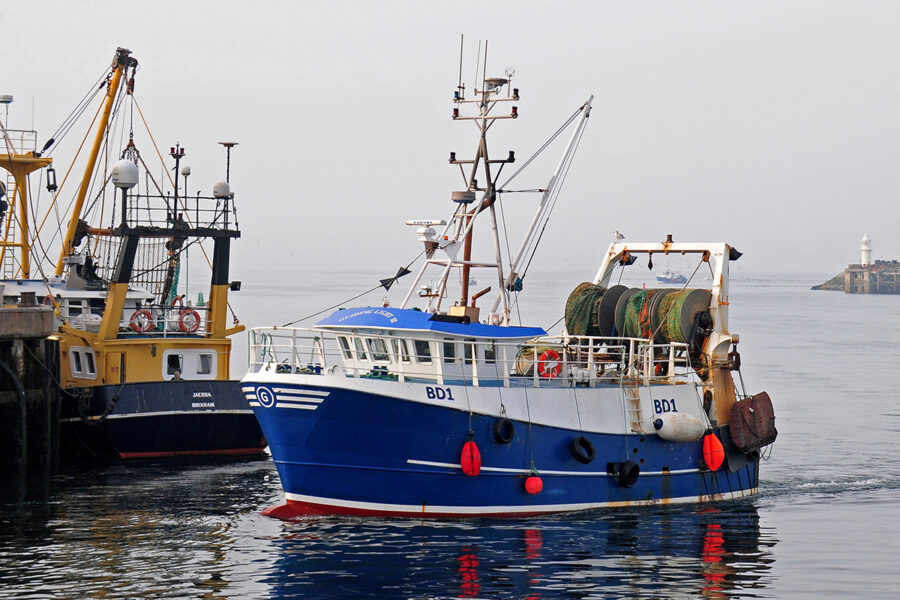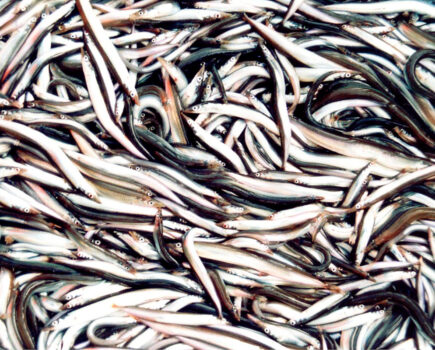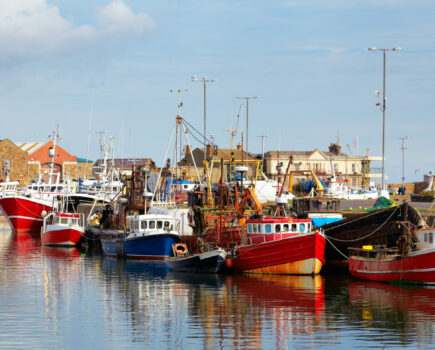‘Black Gold’ attracts a large fleet of visiting vessels to Brixham.
Above: The Looe-owned trawler Guiding Light III heads in to Brixham after fishing cuttles…
The autumn and early winter cuttlefish season off the coast of South Devon started with a bang last month, when a large fleet of trawlers contributed to unprecedented levels of activity in the region, as portrayed in this selection of photographs taken by Martin Johns.
The vagaries of any seasonal fishery were avidly illustrated in September, when the cuttle fishery off the south coast of Devon quickly moved through the gears to provide a particularly dramatic kick start, before levelling out at the beginning of this month, reports David Linkie.
In the early weeks of the fishery, around 100 boats were fishing off the south coast of Devon. In addition to Brixham day boats and beamers, the fleet included vessels from neighbouring ports in the South West, including Plymouth, Looe, Mevagissey, Newlyn and Bideford.
More distant locations, including Fraserburgh, Shetland, Portavogie, Kilkeel, Clogherhead and Castletownbere have also been well represented. Boats that covered considerable distances to take part in the cuttle fishery in September include Allanah Riley S 40, Copious LK 985, Deliverance FR 254, Elegance PD 33, Ellie Edhamh WD 207, Lucinda Anne B 313, Northern Osprey N 76, Patrick C DA 107, Prolific LK 986, Revival FR 316, Saint Rosa SO 711, St Catherine Laboure DA 54, Supreme II DA 38, Tranquillity BF 7 and Vision III BF 191.
Daily landings of cuttlefish to Brixham market have averaged around 750 boxes (40kg). After some boats fished the weekends, Brixham Trawler Agents conducted bigger auctions of around 2,500 boxes (100t) on some Monday mornings in September. Prices have been generally consistent since the start of the fishery, with a high of around £5 and a recent average of £4.20 per kg. 1,108t of cuttlefish were sold for £6.9m on Brixham market in September, which means that the port is well-placed to come close to the 2016 record-breaking total of £30.7m. This total included £8.4m for 2,883t of cuttlefish.
The current cuttle prices are more than double the average £2 per kg that prevailed just three years ago. One of the main reasons for the significantly higher prices is attributed to a global shortage of supplies, following reduced catches in the Indian Ocean.
The majority of cuttle sold on Brixham market, where Coombe Fisheries, Falfish, Ocean Fish and Samways are among the main buyers, is exported to customers in France, Italy and Spain, as well as some further afield.
Considerable amounts of effort and time have clearly been put into developing new markets for Brixham cuttles by all concerned, which is now proving beneficial. In addition to increased turnover on Brixham market, as well as at Plymouth and Newlyn, the buoyant cuttle season also brings further benefits, including the supply of fuel and ice at the top three ports in England.
Although catch rates levelled out at the beginning of October, it is hoped that the fishery will continue to give well-balanced landings that will continue to secure strong prices for the remainder of this year.
Seasonal diversity
Clearly marked seasonal fisheries offering alternative target species have always been widely recognised as playing a vital role in successful inshore fishing. Not only does diversification of fishing effort promote more widely-balanced catches and stronger market demand for all species landed throughout the year, but it also reduces effort on other key fisheries.
Since the millennium, cuttlefish has become an increasingly important alternative species for local and visiting boats, mainly operating from Brixham. Cuttles are caught by inshore trawlers mainly on grounds lying some 10 and 16 miles offshore midway between Berry Head and Portland Bill. Beamers also catch cuttlefish when fishing mainly in the deeper water off Start Point and to the west of Portland Bill, on grounds inshore trawlers cannot work.
Mature cuttlefish move close inshore in Lyme Bay to spawn during the early summer, with particular concentrations being found around river estuaries, which are thought to provide environments favoured by spawning cuttlefish. At this time, cuttlefish are caught by small boats, using traps and trammel nets set tight inshore. On hatching, juvenile cuttlefish are voracious feeders and, as a result, very fast-growing. This rapid growth pattern is directly associated to the fact that cuttlefish have a very short hereditary life span of between 12 and 18 months. Cuttlefish have a parrot-like beak hidden inside the mantle, which they use very effectively when feeding, to nibble chunks out of other fish.
Cuttlefish is the common name applied to Sepia officinalis cephalopod molluscs that have 10 tentacles, eight of which have suction cups on their inner surface and two are longer and can shoot out for catching prey. The body is short, broad and flattened, with a reduced internal shell composed of calcium-rich aragonite and popularly called cuttlebone, embedded in the enveloping mantle. Cuttlefish up to 500mm in length are caught by Brixham vessels, although 300-400mm tends to be the more usual size of larger specimens. Featuring delicate markings on their backs, cuttlefish are able to undergo a complexity of colour changes, ranging from pink to brown with varying stripes and spots.
Read more from Fishing News here.








